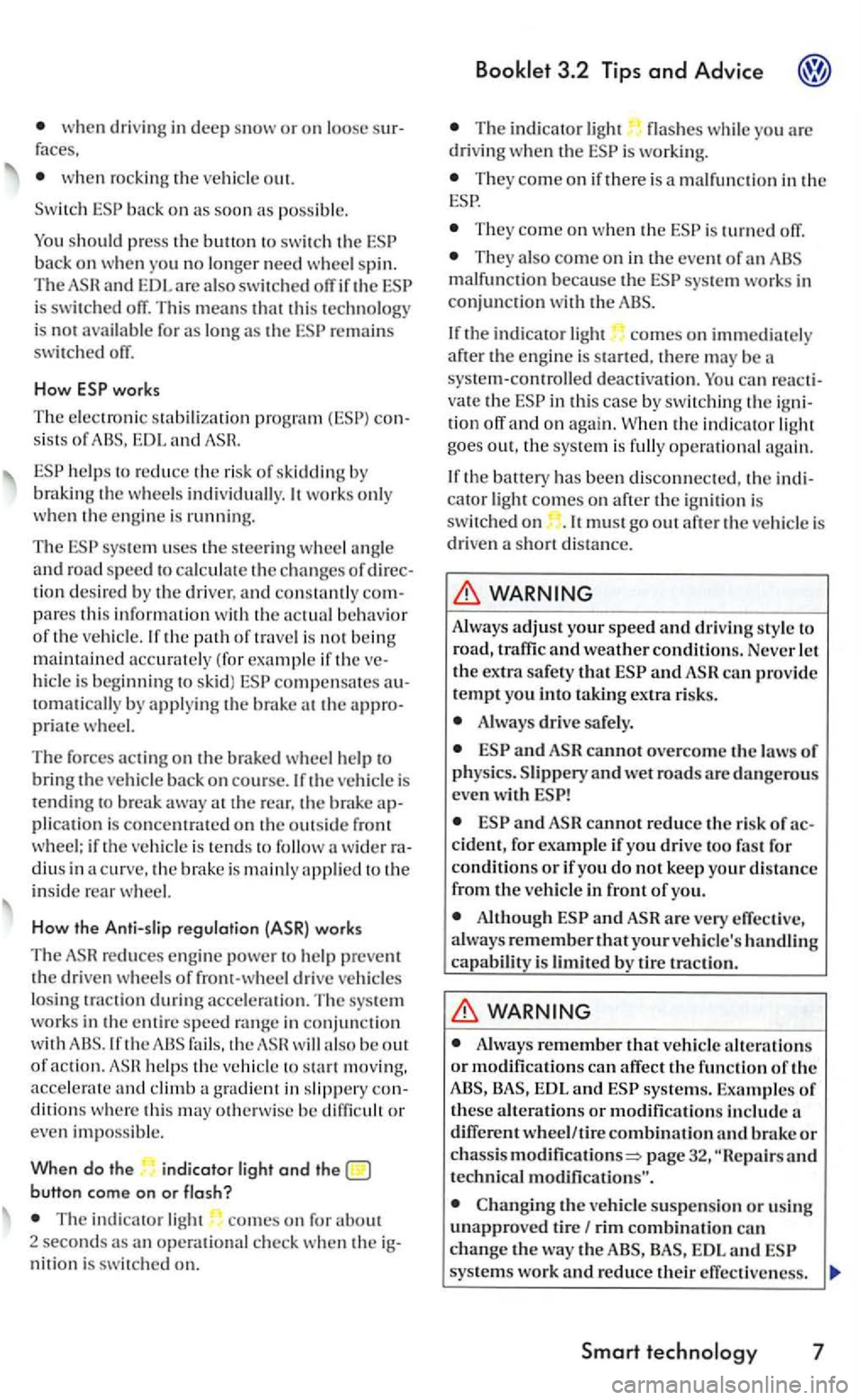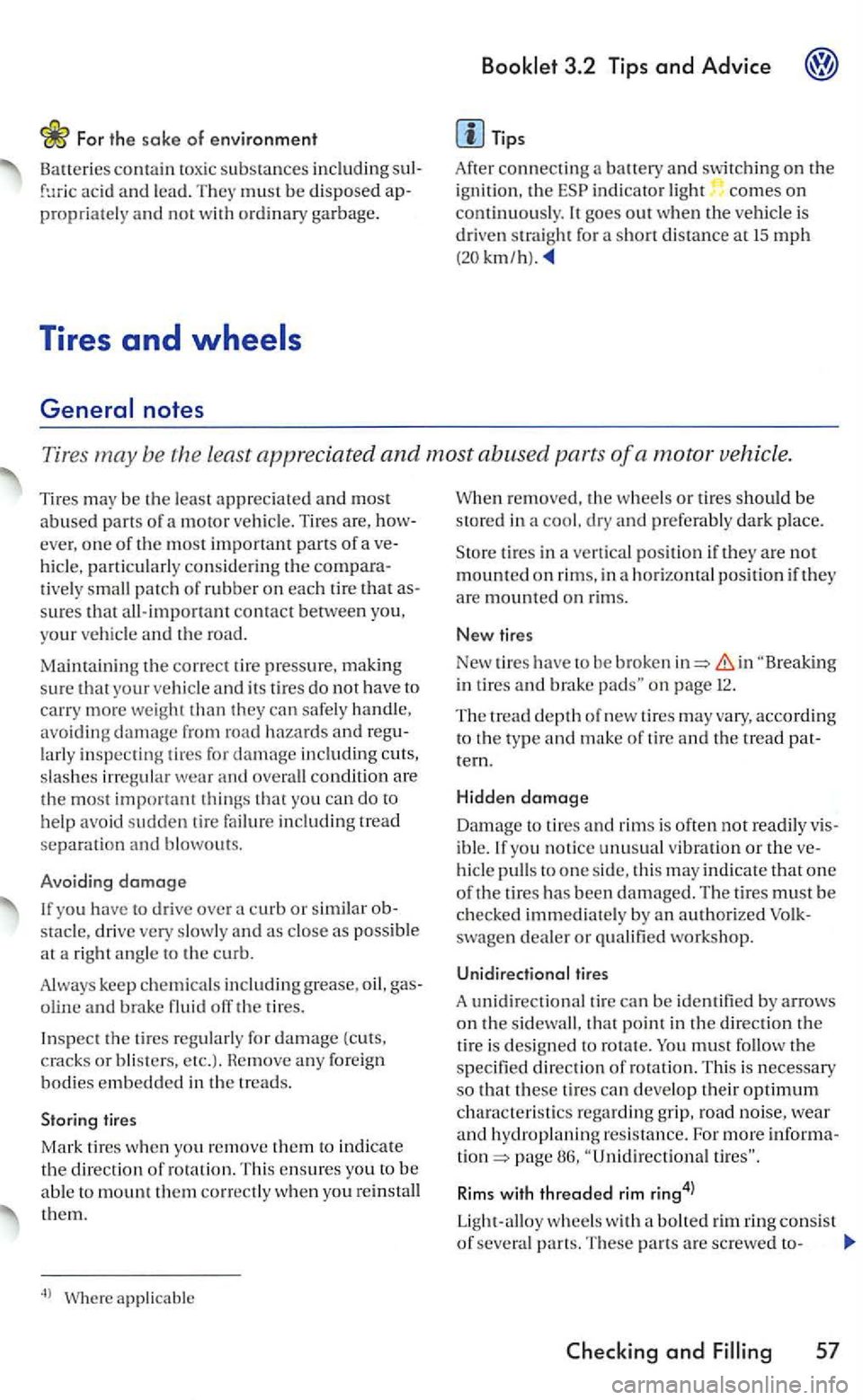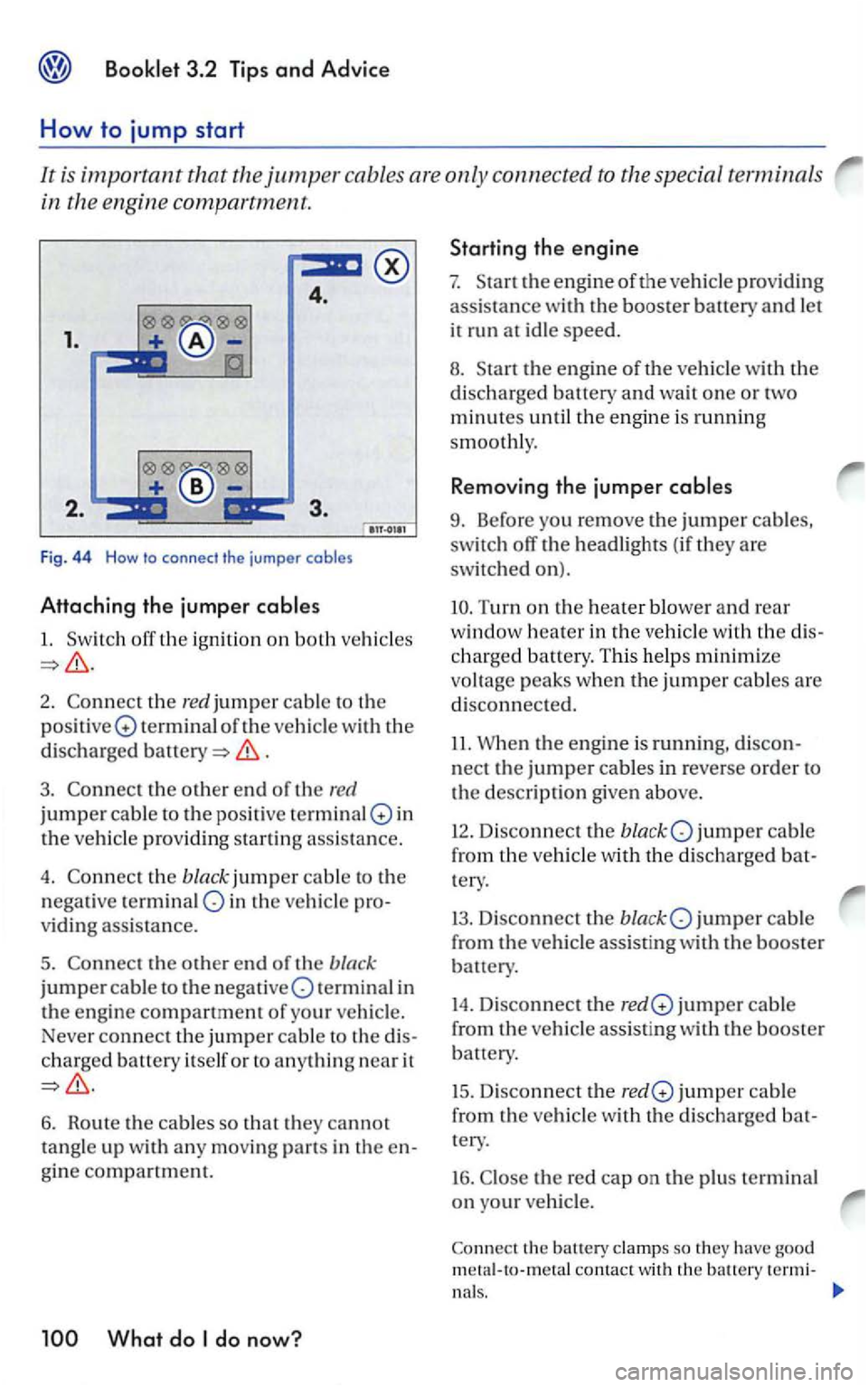2008 VOLKSWAGEN GOLF battery
[x] Cancel search: batteryPage 283 of 444

when dri ving in deep snow or on loose faces.
w he n r ocking the ve hicl e out.
Switch
ba ck on w he n yo u no longer need wheel s pin. The
remains switch ed oiT.
Ho w
works
The electroni c stab ilization progra m
helps to reduce the ris k of skiddin g braking th e w heels individually. works o nl y
w he n th e e ngine is ru nning.
The sys te m uses th e steering whee l an gle and road speed to calculate th e changes of tio n desired by the driver, and constantl y pares thi s informat ion with the actual behavior of the vehicl e. accurately ( for example if the hicle is beginni ng to skid ) tomatically by applyin g th e at the priate wheel.
The forces acti ng on the braked wheel help to
b rin g the vehicle back on course. th e ve hicl e is tending away at the rear, the brake
wide r dius in a curve. th e brake is mainly applied to the
in sid e wheel.
How the Anti-slip regulation
reduces engine powe r to he lp preven t the driven wheels of front-wheel d rive vehicles
losing traction during acceleration. The sys te m works in the entire speed ra nge in conjunctio n
with fails , the will a lso be out of action. h elp s the ve hicl e to moving. accele rat e and climb a grad ient in slipp ery d itions wh ere thi s may o therwise be diffi cult or even imposs ibl e.
When do the indicator light and the button come on or flash?
T he indicator light comes on for about
2 seconds as o perati o nal check when the
3.2 Tips and Advice
The indicator ligh t flashes while yo u are driv ing when the is wo rking.
They come on if there is a malfun ction in the
They come on when the
Th ey also come o n in the event of an malfunction because the system works in conjunction with the ABS.
the indicator light comes on immedia tel y
a fter the engine is started , th ere m ay be a
sys tem-controlled deactivation. You can vate the tion off and on agai n. th e in dicator ligh t
goes out , the sys te m is full y ope rational again.
the battery has been disconnected, th e
A lways adjust your speed and driving style to road, traffi c and weather conditions. Never le t the extra safety that can provide tempt you into taking extra risk s.
Alway s drive sa fe ly .
and
cannot reduc e the ris k of cident, for example if you drive too for conditions or if you do not keep your distance from the vehicle in front of yo u.
Although
Always remember that vehicle alterations or modificatio ns can affec t the functio n of the EDL and
different wheel/ tire combination and brake or chassis modifications=> page 32, and technical modifi cations".
Changing
EDL and sys te m s work and reduce their effecti veness.
Smart
Page 331 of 444

booklet 3.3 ""Technical
Warnin g notes on hand lin g battery
p ro tect ive
g loves an d eye protect ion!
Fir es, sparks, open lights and smoking are prohibi te d !
hi ghl y ex plo sive mixtu re of is give n off whe n the battery
i s under c h arge.
keep frn m
acid and battery !
WARNING
Working on the battery or th e e lectri ca l
sys tem in your vehicl e ca n res ult in serio us
acid burns, fires or elec tri ca l s hock . Always
read and heed th e follow ing W/\HN INGS and
safe ty preca utions before work ing on th e
Befo re wo rking o n th e electrica l system, ways switc h off the ignit ion and all elec trical
co nsumers and disconnect the nega tive(-) cabl e from the battery. When light bu lb is
changed, always switc h off th e light .
Turn ofT the anti-theft ala rm by unlockin g the vehicl e before you disconnect the ba ttery
to preve nt the from on.
A lway s kee p children
Always wear eye protection. Never let tery acid or lead particles contact your eyes ,
s ki n and clothing.
Sulfur ic battery aci d is ve ry corros ive and can cause damage to unp rot ected skin and
(continued)
blind ness. Always wear protective g loves an d
eye pro tectio n. To reduce your risk of injury, n ev e r tilt the battery, as thi s could spill acid
th ro ug h th e vents and m ake burn yo u.
W he n disconnec ting the ba tt ery fr o m the vehicl e electrica l sys te m , a lways disconnec t
th e nega tive cable(-) fir st and th en th e tive cable(+).
A hig hl y exp los ive mixtu re of is given
off w he n th e battery is being charged.
A lway s avoi d fires, sp a rk s, open and sm oki ng. Always avoid generati n g sparks and electros ta ti c ch arges when h andling cabl es
and e lec tric a l equipme nt . Neve r sh o rt -ci rc u it
th e ba tte ry po les. High-energy sp a rk s can
ca u
se serio us personal injury.
Alway s switch off all electri cal consumers befo re reconnec ting the batt ery. Recon nect
t h e plu s ca ble(+) first and then th e negat ive
cable(-). Never reve rse the po larity of the
Never ch arge
F C).
Alwa ys make su re that th e ve nt hose is nect e d to the battery.
Neve r usc dam age d battery-they can plode! Immed ia te ly rep la ce dam age d battery.
tion immediately. lfyo u in ges t any batt ery
a cid , seek medic al atte ntion immedia tely.
WARNING
Ca lifornia 65 Warning:
Battery posts, termina ls and re la ted sories con tai n lead a nd lea d compo ne n ts ,
c h em ica ls known to the
and
Page 332 of 444

(continued)
cause cancer and reproductive harm. Wash
h ands afte r handling.
Do no t d isconnect th e battery if the ig nit io n
i s swit ch ed on or if the e ng in e is running. Thi s
Warning
could damage the e lectrical sys tem or electronic compon ents.
Do not expose the battery to direct sunlight
for long periods of tim e, ultrav io let rays can
damage the battery hous ing.
Thi s warning light sign als a fault in the generator.
The warning light lights up when the ign itio n
is sw itch ed on. should go out when the engin e
s ta rt s running.
the wa rning light lights up w hile driving.
t h e ge ne rator is no lon ger charg ing th e battery. should imme dia te ly driv e to the neare st
Volkswagen dealer or qu alified wo rk shop.
However, you should avo id usin g e lectrical equipment that is not absolu tely necessary because thi s
If yo u do not pay attentio n to the warnin g
li ghts which have come on, including the warning messages appearing in the display, th is could lead to personal injury or damage to your vehicl e_
Charging and
this we recommend you
h ave the ve hicle battery ch ecked by an authorize d Volkswage n dealer w here it be prop
erly recharged or re pl aced .
Chargin g ve hicle battery
Th e charging of the ve hicle battery should le ft to an authorize d Volkswage n deale r or qual ified
w orks hop. because your ve hicl e is equip pe d
wi th special ba tt ery that must be charged in a environment.
56 Checking and
A lways use onl y m aintenance-free or cycle -free , leak-proof batteries with the same specification s and d im en sio ns as the orig in al equipment battery- Specifi cations arc listed o n the battery ho using_
in of on page 55.
Page 333 of 444

For th e sake of e nvironment
Baueries contain toxi c substances including aci d and lead. must b e disposed propriately and not with ordinary garbage.
Tires and
General notes
Tips
After connecti n g a battery and switching on the ig nit ion, the indicator light comes on continuously. It goes out when the ve hicl e is dri ven straigh t for a short distance at 15 mph km/h ).
Tire s may be the least appreciated and most abused parts of a motor vehicle.
Tires may be the lea st appreciated and most abuse d pa rts of a motor ve hicle. Tire s are, eve r, one of the mos t important parts of
safe ly handle,
avoi din g from road h aza rds and inspecting tires for damage including cuts,
sl ash es irregular wea r you can do to help avoid sudden tire fa ilur e including tread separation and blowouts.
Avo iding
damage
lfyou have to drive over stacle, drive very slowly and as close as poss ibl e
Wher e ap pli cabl e W
h
en removed, the wheels or t ires should be stored in cool. dry and p re ferably dark plac e.
tires in ve rtical position if they are not mounted on rims, in ho rizontal posi tion if they
in " 'B reaking in tire s and brake
type tern.
Hidd
en damoge
Da
mage t o tire s rims is often not readily
swage n dealer or qu alified workshop.
Unidir ection al tires
A unidirectio nal tire can b e idemified by arrows on the sidewall, that p oint in the direction the tire is designed to rota te.
p ag e "Unidirectional
Rims with threaded rim ring4l
Light-allo y wheels w ith a bolted rim ring consis t
o f several parts. T hese parts are screwe d to-
57
Page 375 of 444

-Place the flat blade of th e screwdri ver
into the fig. 42
the cover off care full y in the dir ec
tio n of the a rrow.
Replacing
th e ig nit ion off and remove th e
key fr
om the ig nitio n lock.
- T
urn the lamp holder upwards and pull
the lamp holder out alo ng w ith the lig ht
bulb.
- Rep l
ace th e light bulb.
- Install
the lamp h o lder w ith the new
light bulb.
-
Turn t h e lamp hold er against the direc
tio n of th e a rrow back to its o rigina l posi
tion until it e n gages.
Booklet 3.2 Tips and Advice
-Press on the cove r until it engages
firmly.
There are parts with sharp ed ges on the opening and on the lamp holder. h and protection when yo u replace bulbs .
authorized Volk
s w age n dealer or a qu alifi ed workshop. rious person al injury may
Do not touch glass bulb with hands. Fingerprints can cloud the outer s u rface of the bulb
w hen heated. thus affect ing th e reflection, th us reducing the power of illumin at io n .
A bulb can o nly be rep laced by a bulb of the sam e type. The model identificat io n i s ei ther on the bulb base or on the bulb
cables must h ave sufficient wire cross section.
the engine does not is
disch arged, your vehicle's can be connected the batt ery of another vehicle to start the engine.
Jumpe r cables
T he wi re cross section mu st be in2
(25 1111112
) fo r g asoli ne e ngines.
Do no t let the ve hicles each other, o therwise current could flow as soon as th e plus(+) terminals areconnected.lf necessary.use longer jumpe r cables.
T he discharged battery must be p roperly connected to th e ve hicle's
What do
Page 376 of 444

4.
1.
F ig. 44 How to connect the jumper cables
Attaching the jumper
1.
2. the red jumper cable to the
positi ve Q terminal of the vehicle with the
disch arg ed
.
3 . the other end of th e red
jumpe r cable to the posit ive terminal in
the veh icle providing startin g ass is ta n ce.
4. the black jumper ca ble to the
negative terminal in the vehic le
v idin g assistance.
5.
ch arged battery itself or to anything near it
6. Route the cables so that they cannot
tangle up with an y mo vin g parts in the
the engine of the vehicle with the
discharged battery and wait one or two
minutes until the engin e is running
s m
oothly.
Removing the jumper
9. Before you remove th e jumper cables,
switch off the headlights (if they are
switched on).
Turn on the heater blower and rear
window heater in the vehicl e with the
charged battery. This helps minimi ze
voltage peaks wh
en the jumper cables are
di sconnected.
11. Whe n the engine is running,
nect the jumper cables in r everse order to
the description given above.
12. Disconnect the jumper cable
fro m the vehicle with the di
scharged
jumper cable
from
the ve hicle assist ing with the booster
battery.
14. Disconn ect the jumper cabl e
from
the ve hicle assisting w ith the booste r
battery.
15. D isconnect the jumper ca ble
from the
vehicle with the discharged
th e re d cap on th e plu s te rminal
on your vehicle .
contact with the battery
Page 377 of 444

If th e e ng ine docs not stan, rum off the aft er ab o ut se cond s a nd try again about seconds.
39. The engine compartment of an y
motor vehicle is a potentiall y dangerous area and can cause seriou s personal injury.
tery explos ion:
Always make sure that the battery viding starting ass istance has the same voltag e as the di scharged battery (12 V) and
appr oximate ly the same capacity (see battery
lab el).
Never jump start a ve hicl e wit h a fro zen
battery. The battery can explode. If a battery i s or h as been frozen, re place it.
Batteries give off exp losive hydrogen gas.
Always keep sparks, open flame and
s moking mate rial s away from batteries.
(continued)
Never short out the battery poles by necting the positive and negative pole s
with each other.
Always follow the jumper cables '
Never connect the negativ e cable from the other vehicle directly to the negativ e terminal of th e di sc harged battery. The hydrogen from the battery is exp los ive.
Never attach the negativ e cabl e from the ve hicl e provid.ing starting assis tanc e to parts of the fuel system or to the brake hoses or brake lines.
Never the non-in sulated parts ofthe battery clamps to touc h. Never allow the jumper cable attached to the positive battery
terminal to contact metal parts of the vehicle.
Always rout e the jumper cables so that
they cannot tangled up w ith moving parts in the engin e compartment.
Note
Install ing jumper cables imp roper ly can
ca use expe nsive damage to the vehicl e's trical system.
Do not let the vehicle s tou ch each othe r. e rwise current could flo w between th e cars as soon as the plus(+) te rminal s arc
What do
Page 384 of 444

light 5
See Anti-lock brake
should want to add an acces-sor y to my ve hicl e?
Add ress of
Add ress of Transport
Afte r c hanging a w heel 87
Alloy
wheels
fe el a slight v i
b ration on the brake pedal? 4
Ant i-t h
eft alarm system
Linking your trailer
Anti-theft wheel bolts 84
A uto Safety Hotline
Automatic car wash 22
B
3
Batt ery
56
low often should replace m y engin e
battery? 56
Important informatio n t o know befo re
d isconnect the battery 55
Hcplac ing
56 yo u must do after reconnect the battery 55
is the correct brake nuidleve l?. 53
Brake syste m 53
light 2
B rak
es low docs mois ture or road salt affect the brakes? 13
does it mean when feel a slight vibra tion o n the brake pedal? 4
Br
aking distance 13
Break-in period
Engin e 12
is the right way to break-in my vehicle? 12
Br e
aking in
B r
ake pads 12
Ti r
es 12
Break ing in
tires 12
Bulb ch
ange 93
Bulb fa
ilure 93
65 39 , 55
22
ra di o 33
phone 33
phone 33
a bulb 93
a w heel 86
brake pads
fuel cap 36
engine oil leve l 44
26